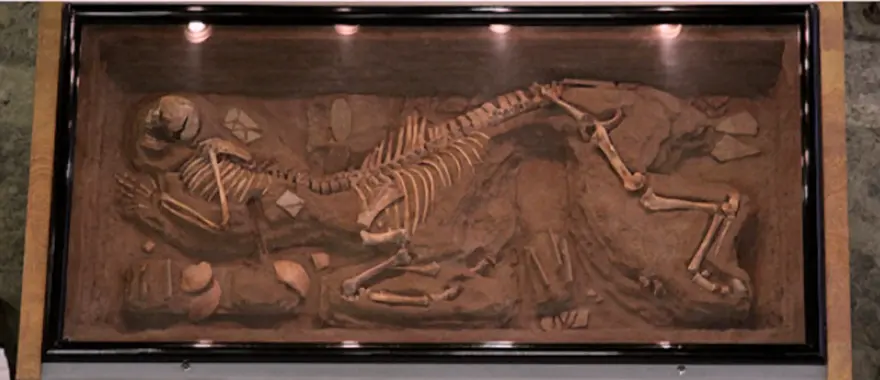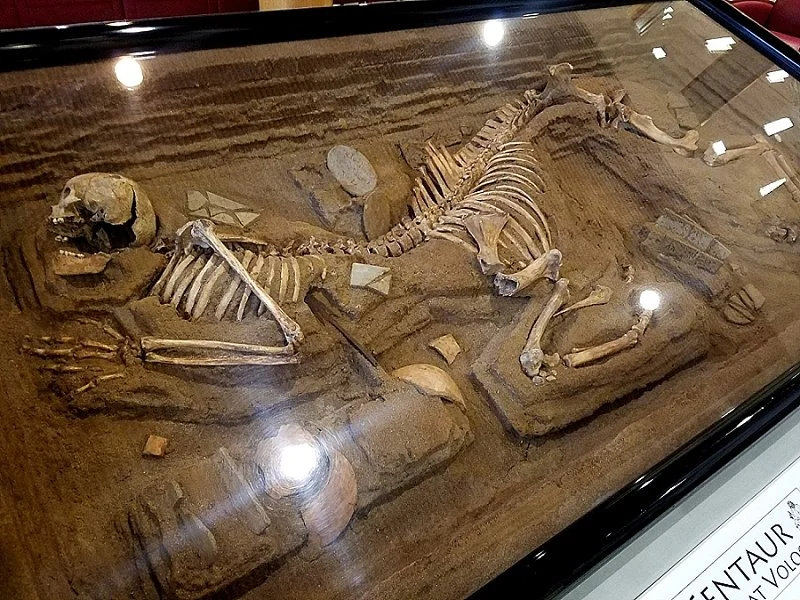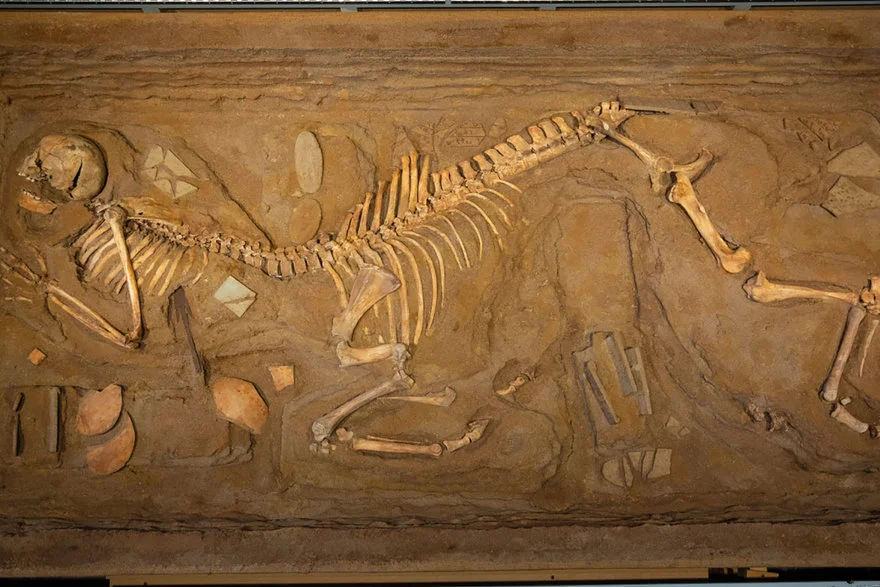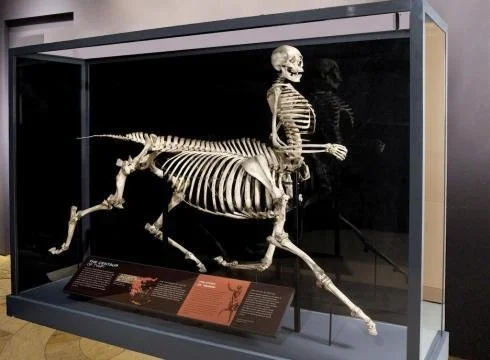



































An Excavated Centaur Skeleton from 1980
1980年发现的半人马骨架
"One of three centaur burials discovered in 1980 by the Archaeological Society of Argos Orestiko eight kilometers northeast of Volos, Greece"
1980年希腊奥雷斯蒂科阿尔戈斯考古学会在沃洛斯东北8公里处发现的三个半人马墓葬之一
By
通过
Rain Noe
野江雨
-
April 27, 2020
2020年4月27日,
in
在
Object Culture
客体文化


The plaque on "The Centaur of Volos," which was first exhibited in 1980 at the Madison Art Center in Wisconsin, reads:
“沃洛斯的半人马”牌匾于1980年在威斯康星州的麦迪逊艺术中心首次展出,上面写着:
"One of three centaur burials discovered in 1980 by the Archaeological Society of Argos Orestiko eight kilometers northeast of Volos, Greece."
“1980年,位于希腊沃洛斯东北8公里处的阿尔戈斯-奥雷斯蒂科考古学会发现了三个半人马墓葬之一。"
The human bones are real, as are the horse bones. But they were conjoined and staged by a guy named Bill Willers. According to researcher and forensic-science writer Dolly Stolze at the
Strange Remains
forensic anthropology website:
人骨是真实的,马骨也是。但他们是由一个叫比尔·威勒斯的人联合策划的。根据法医人类学网站
Strange Remains
的研究员和法医科学作家Dolly Stolze的说法:
In 1980, Bill Willers, artist and professor of Biology at the University of Wisconsin-Oshkosh, constructed the skeletal remains of The Centaur of Volos from real human bones and the bones of a Shetland pony. The human bones that Willers used were from an anatomical specimen, a human skeleton from India, in the biology department at his university. The human and pony bones were tea-stained to give them a uniform color and make them look authentic.
1980年,威斯康星大学奥什科什分校的艺术家兼生物学教授比尔·威勒斯(Bill Willers)用真实的人骨和一匹设得兰群岛小马的骨头建造了沃洛斯的半人马骨架。威勒斯使用的人类骨骼来自他所在大学生物系的一个解剖标本,一个来自印度的人类骨骼。人类和小马的骨头被染成了一种统一的颜色,使它们看起来更真实。

"The Centaur of Volos" toured a series of colleges in the 1980s, before being purchased by the University of Tennessee-Knoxville in 1994. It is now on permanent display in their Jack E. Reese Galleria at the Hodges Library.
“沃洛斯的半人马座”在1980年代参观了一系列学院,然后在1994年被田纳西州诺克斯维尔大学购买。它现在在他们的杰克E中永久展出。Hodges图书馆的Reese Galleria
In 2008, Willers was commissioned by Skulls Unlimited--a company that sells real bones, both human and other--to create another centaur skeleton, this one posed:
2008年,威勒斯受头骨无限公司的委托--一家出售人类和其他真实的骨头的公司--制作另一个半人半马的骨架,这一个构成:

"The Centaur of Tymfi" was exhibited at Arizona's International Wildlife Museum in 2012 as part of a "Mythological Wildlife" exhibit. It was subsequently purchased by The Barnum Museum in Connecticut. (Fun fact: "The Centaur of Tymfi" actually uses zebra, not horse, bones.)
2012年,作为“神话野生动物”展览的一部分,“Tymfi的半人马”在亚利桑那州的国际野生动物博物馆展出。它随后被康涅狄格州的巴纳姆博物馆购买。(Fun事实:《泰姆菲的半人马》实际上使用的是斑马的骨头,而不是马的骨头。
As for why "The Centaur of Volos" was ever created and exhibited, according to
Stolze
:
至于为什么“沃洛斯的半人马”曾经被创造和展出,根据
斯托尔泽
:
The exhibit was designed to encourage students to rely on their critical thinking skills, and not accept everything as fact no matter how believable it looks or sounds, even from a reliable source like a university exhibit.
该展览旨在鼓励学生依靠他们的批判性思维能力,而不是接受一切作为事实,无论它看起来或听起来多么可信,即使是从一个可靠的来源,如大学展览。
And according to
Roadside America
,
Willers "had conceived of the centaur as a way to test the public's willingness to believe the unbelievable, just as P.T. Barnum did."
根据《
路边美国》
的报道,
威勒斯“把半人马作为一种测试公众是否愿意相信难以置信的东西的方式,就像P. T。巴纳姆做到了。"
In this day and age, I'm relatively certain I could post the "Volos" photos on Facebook and get
at least
five people to believe it. And circulate it.
在这个时代,我相当肯定我可以在Facebook上发布“沃洛斯”的照片,让
至少
五个人相信它,并传播它。
See Also:
另请参阅:
The Swayzaur
Swayzaur
o
1
Favorite This
收藏此
Q
Comment
评论
Share your thoughts
分享你的想法




































